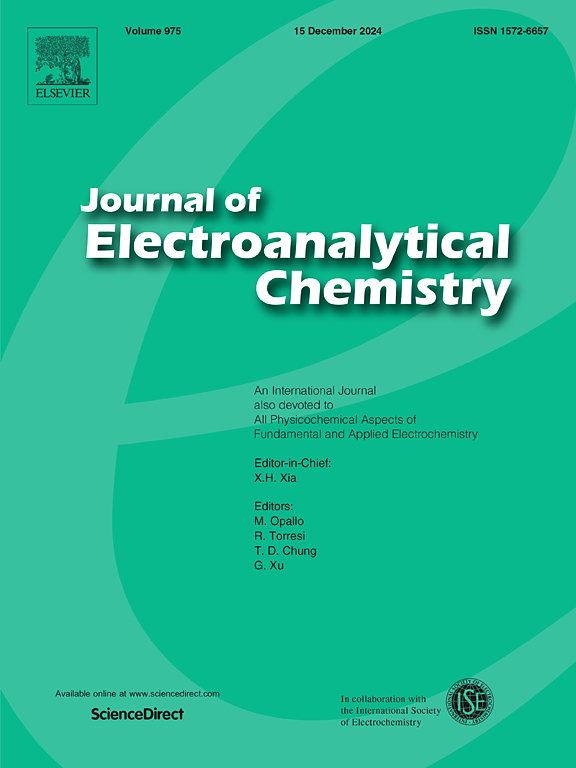Enhanced oxygen evolution reaction activity and stability through Fe and Cr Co-incorporation in cobalt hydroxide
IF 4.1
3区 化学
Q1 CHEMISTRY, ANALYTICAL
引用次数: 0
Abstract
Efficient and durable electrocatalysts are essential for advancing sustainable energy conversion, particularly for the oxygen evolution reaction (OER) in water splitting. However, overcoming the complex, multi-electron OER mechanism remains a significant challenge, with the formation of high-oxidation-state metal–OOH (M–OOH) intermediates acting as the rate-limiting step. Here, we present a high-performance CoFeCr (oxy)hydroxide electrocatalyst, synthesized by strategically incorporating Fe and Cr into a Co matrix. The co-incorporation of Fe and Cr transforms flake-like Co hydroxide into uniform nanospheres, significantly enhancing OER activity through the formation of abundant oxyhydroxide species. This catalyst exhibits exceptional OER performance, with a low overpotential of 203 mV at 10 mA cm−2 and a Tafel slope of 42.03 mV dec−1 in 1 M KOH. Furthermore, it maintains excellent stability over 100 h of continuous operation at 100 mA cm−2 in 1 M KOH. The superior performance is attributed to the synergistic effects of Fe, which accelerates OOH intermediate formation, and Cr, which improves electrical conductivity and stabilizes active sites by forming high-valence Cr6+ species. The CoFeCr (oxy)hydroxide electrocatalyst significantly outperforms state-of-the-art NiFe-based counterparts, establishing itself as a robust and efficient electrocatalyst for large-scale water splitting.
铁和铬共掺入氢氧化钴中,增强析氧反应活性和稳定性
高效、耐用的电催化剂是促进能量可持续转化的重要手段,特别是对析氧反应(OER)。然而,克服复杂的多电子OER机制仍然是一个重大挑战,高氧化态金属ooh (M-OOH)中间体的形成是限速步骤。在这里,我们提出了一种高性能的CoFeCr(氧)氢氧化物电催化剂,通过将Fe和Cr策略性地结合到Co基体中来合成。铁和铬的共掺入使片状氢氧化co变成均匀的纳米球,通过形成丰富的氢氧化物,显著提高了OER活性。该催化剂表现出优异的OER性能,在10 mA cm−2下的过电位为203 mV,在1 M KOH下的Tafel斜率为42.03 mV dec−1。此外,它在100 mA cm−2、1 M KOH的条件下连续工作100小时以上仍保持良好的稳定性。优异的性能归功于Fe和Cr的协同作用,Fe加速OOH中间体的形成,Cr通过形成高价Cr6+来提高电导率和稳定活性位点。CoFeCr(氧)氢氧化物电催化剂明显优于最先进的基于镍铁的电催化剂,成为一种强大而高效的大规模水分解电催化剂。
本文章由计算机程序翻译,如有差异,请以英文原文为准。
求助全文
约1分钟内获得全文
求助全文
来源期刊
CiteScore
7.80
自引率
6.70%
发文量
912
审稿时长
2.4 months
期刊介绍:
The Journal of Electroanalytical Chemistry is the foremost international journal devoted to the interdisciplinary subject of electrochemistry in all its aspects, theoretical as well as applied.
Electrochemistry is a wide ranging area that is in a state of continuous evolution. Rather than compiling a long list of topics covered by the Journal, the editors would like to draw particular attention to the key issues of novelty, topicality and quality. Papers should present new and interesting electrochemical science in a way that is accessible to the reader. The presentation and discussion should be at a level that is consistent with the international status of the Journal. Reports describing the application of well-established techniques to problems that are essentially technical will not be accepted. Similarly, papers that report observations but fail to provide adequate interpretation will be rejected by the Editors. Papers dealing with technical electrochemistry should be submitted to other specialist journals unless the authors can show that their work provides substantially new insights into electrochemical processes.

 求助内容:
求助内容: 应助结果提醒方式:
应助结果提醒方式:


